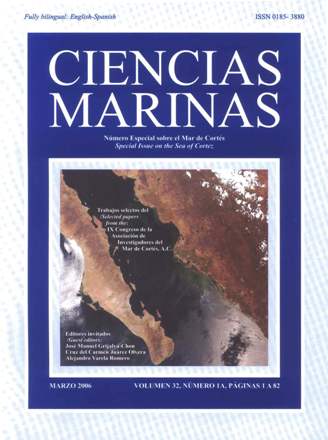Postlarval ecology of the blue shrimp (Litopenaeus stylirostris) and brown shrimp (Farfantepenaeus californiensis) in the Colorado River Estuary.
Main Article Content
Abstract
The study describes habitat use by penaeid shrimp larvae that enter the Colorado River Delta. A location was chosen in the Santa Clara Channel in the core zone of the Upper Gulf of California and Colorado River Delta Biosphere Reserve, where collections were done during three consecutive days of each spring tide from May to October 2000. A 505-µm net was anchored and left in the water for 10 minutes when the height of the tide was 1 m above the level of the channel, during both flood tide and ebb tide. Blue shrimp (Litopenaeus stylirostris) and brown shrimp (Farfantepenaeus californiensis) postlarvae were caught in proportions of 80% and 20%, respectively. The postlarval abundance of blue shrimp was significatively greater during flood tide than during ebb tide in May, June and September, but significatively greater during ebb tide than during flood tide in July and August. The blue shrimp postlarval sizes were significatively greater during ebb tide than during flood tide. No differences in the abundance of brown shrimp postlarvae were found between flood and ebb tides. It is concluded that the Colorado River Delta is a breeding area for blue shrimp, but not for brown shrimp.
Downloads
Article Details
This is an open access article distributed under a Creative Commons Attribution 4.0 License, which allows you to share and adapt the work, as long as you give appropriate credit to the original author(s) and the source, provide a link to the Creative Commons license, and indicate if changes were made. Figures, tables and other elements in the article are included in the article’s CC BY 4.0 license, unless otherwise indicated. The journal title is protected by copyrights and not subject to this license. Full license deed can be viewed here.

